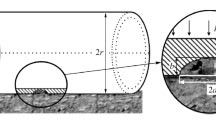We propose a mathematical model for the determination of the period of subcritical crack growth in an oil pipeline operating under the action of constant internal pressure, hydroshocks, and soil corrosion with regard for the degradation of its material. The model is based on the first law of thermodynamics, i.e., on the balance of energy components and the rates of their variations, the mechanisms of electrochemical corrosion, and the analytic dependences of changes in the stress-corrosion characteristics of the material in the course of time (degradation). We determine the residual lifetime of an oil pipeline made of Kh60 steel.
Similar content being viewed by others
References
V. M. Agapkin and B. L. Krivoshein, Methods for the Protection of Pipelines Against Failures in Nonstationary Modes [in Russian], VNIIOÉNG, Moscow (1976).
O. E. Andreikiv, O. V. Hembara, O. T. Tsyrul’nyk, and L. I. Nyrkova, “Evaluation of the residual lifetime of a section of a main gas pipeline after long-term operation,” Fiz.-Khim. Mekh. Mater., 48, No. 2, 103–110 (2012); English translation: Mater. Sci., 48, No. 2, 231–238 (2012); https://doi.org/10.1007/s11003-012-9497-7.
O. E. Andreikiv, I. Ya. Dolins’ka, V. Z. Kukhar, and I. P. Shtoiko, “Influence of hydrogen on the residual service life of a gas pipeline in the maneuvering mode of operation,” Fiz.-Khim. Mekh. Mater., 51, No. 4, 59–66 (2015); English translation: Mater. Sci., 51, No. 4, 500–508 (2016); https://doi.org/10.1007/s11003-016-9868-6.
O. Ye. Andreikiv, I. Ya. Dolins’ka, I. P. Shtoiko, O. K. Raiter, and Yu. Ya. Matviiv, “Evaluation of the residual service life of main pipelines with regard for the action of media and degradation of materials,” Fiz.-Khim. Mekh. Mater., 54, No. 5, 33–39 (2018); English translation: Mater. Sci., 54, No. 5, 638–646 (2019); https://doi.org/10.1007/s11003-019-00228-9.
O. Ye. Andreikiv, I. Ya. Dolins’ka, and N. V. Yavor’ska, “Growth of creep cracks in structural elements under long-term loading,” Fiz.-Khim. Mekh. Mater., 48, No. 3, 12–17 (2012); English translation: Mater. Sci., 48, No. 3, 266–273 (2012); https://doi.org/10.1007/s11003-012-9502-1.
L. D. Kudryavtsev, A Course of Mathematical Analysis, Vol. 1 [in Russian], Vysshaya Shkola, Moscow (1981).
Z. V. Slobodyan, H. M. Nykyforchyn, and O. I. Petrushchak, “Corrosion resistance of pipe steel in oil-water media,” Fiz.-Khim. Mekh. Mater., 38, No. 3, 93–96 (2002); English translation: Mater. Sci., 38, No. 3, 424–429 (2002); https://doi.org/10.1023/A:1021738103745.
N. I. Tym’yak and O. E. Andreikiv, “Evaluation of crack-growth rate under conditions of simultaneous action of static loading and corrosive media,” Fiz.-Khim. Mekh. Mater., 31, No. 2, 68–74 (1995); English translation: Mater. Sci., 31, No. 2, 219–225 (1996); https://doi.org/10.1007/BF00558642.
Ecological Aspect of the Transportation of Oil in Oil Pipelines [in Ukrainian]; http://4ua.co.ua/ecology/va2ac78a4c53a88421316d37_0.html.
O. T. Tsyrul’nyk, Z. V. Slobodyan, O. I. Zvirko, M. I. Hredil’, H. M. Nykyforchyn, and G. Gabetta, “Influence of operation of Kh52 steel on corrosion processes in a model solution of gas condensate,” Fiz.-Khim. Mekh. Mater., 44, No. 5, 29–37 (2008); English translation: Mater. Sci., 44, No. 5, 619–629 (2008); https://doi.org/10.1007/s11003-009-9138-y.
Allentown Explosion Kills 5 People, Including 4-Month-Old Boy, 16-Year-Old Girl, Officials Say—UPDATE; https://www.lehighvalleylive.com/allentown/2011/02/a_number_of_people_missing_aft.html.
J. Hu, Y. Tian, H. Teng, L. Yu, and M. Zheng, “The probabilistic life time prediction model of oil pipeline due to local corrosion crack,” Theor. Appl. Fract. Mech., 70, 10–18 (2014); https://doi.org/10.1016/j.tafmec.2014.04.002.
J. Kec, I. Černý, A. Poloch, B. Kyselá, and M. Poupa, “Oil transmission pipelines with corrosion defects reinforced by two types of sleeves: comparison efficiency of sleeves,” Proced. Struct. Integr., 37, 598–605 (2022); https://doi.org/10.1016/j.prostr.2022.01.128.
H. Niazi, R. Eadie, W. Chen, and H. Zhang, “High pH stress corrosion cracking initiation and crack evolution in buried steel pipelines: A review,” Eng. Fail. Anal., 120, 105013 (2021); https://doi.org/10.1016/j.engfailanal.2020.105013.
H. Nykyforchyn, O. Tsyrulnyk, and O. Zvirko, “Electrochemical fracture analysis of in-service natural gas pipeline steels,” Proced. Struct. Integr., 13, 1215–1220 (2018); https://doi.org/10.1016/j.prostr.2018.12.250.
F. M. Song, “Predicting the mechanisms and crack growth rates of pipelines undergoing stress corrosion cracking at high pH,” Corros. Sci., 51, No. 11, 2657–2674 (2009); https://doi.org/10.1016/j.corsci.2009.06.051.
O. Stepova, I. Rassoha, L. Blazhko, and O. Hanoshenko, “Calculation of lifetime of steel oil pipelines with the account of corrosive environment affect,” in: V. Onyshchenko, G. Mammadova, S. Sivitska, and A. Gasimov (editors), Proc. of the 2nd Internat. Conf. on Building Innovations, ICBI-2019, Ser. Lecture Notes in Civil Engineering, Vol. 73, Springer, Cham (2020), pp. 721–727.
C. Wang, W. Li, and Y. Wang, “Remaining lifetime assessment of gas pipelines subjected to stray current interference using an integrated electric-electrochemical method,” Eng. Fail. Anal., 127, 105494 (2021); https://doi.org/10.1016/j.engfailanal.2021.105494.
M. Wasim and M. B. Djukic, “External corrosion of oil and gas pipelines: A review of failure mechanisms and predictive preventions,” J. Nat. Gas Sci. Eng., 100, 104467 (2020); https://doi.org/10.1016/j.jngse.2022.104467.
Author information
Authors and Affiliations
Corresponding author
Additional information
Translated from Matematychni Metody ta Fizyko-Mekhanichni Polya, Vol. 64, No. 3, pp. 142–149, April–June, 2021.
Rights and permissions
Springer Nature or its licensor (e.g. a society or other partner) holds exclusive rights to this article under a publishing agreement with the author(s) or other rightsholder(s); author self-archiving of the accepted manuscript version of this article is solely governed by the terms of such publishing agreement and applicable law.
About this article
Cite this article
Andreykiv, O.Y., Dolinska, I.Y. Mathematical Modeling of Growth of Stress-Corrosion Cracks in an Oil Pipeline with Regard for Hydroshocks and In-Service Changes in the Characteristics of its Material. J Math Sci 278, 908–917 (2024). https://doi.org/10.1007/s10958-024-06968-7
Received:
Published:
Issue Date:
DOI: https://doi.org/10.1007/s10958-024-06968-7




